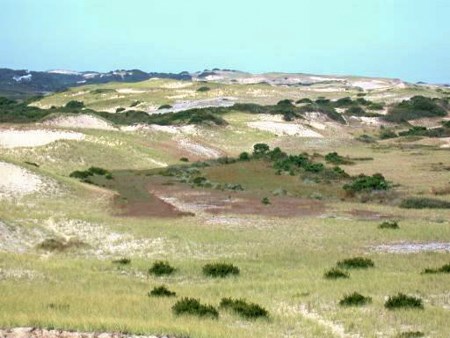
NPS photo CACO dunes are variably covered with vegetation, some of which has established naturally and a small portion of which was planted at various times in an attempt to minimize dune migration. Successful dune species have adaptations to tolerate hot, dry, and sometimes salty conditions. Plants often have a thick, waxy cuticle to limit water loss. In the case of American beachgrass (Ammophila breviligulata), the leaves roll up during hot, dry weather, which reduces transpiration. Common plant species of the dunes include American beachgrass, seaside goldenrod (Solidago sempervirons), poison ivy (Toxicodendron radicans), wormwood (Artemesia campestris ssp. caudata), northern bayberry (Morella pensylvanica), and beach plum (Prunus maritima). In interdunal depressions that are low enough to intersect with the groundwater table for part of the growing season, seasonal wetlands form and support distinct plant communities.
A number of environmental factors have been shown to influence dune plant communities and their patterns of succession or regression. Wind can cause direct physical damage (known as “wind pruning”) to the structural integrity of plants (particularly woody species). Wind also carries salt spray, which can affect plant foliage and/or roots, although it has been suggested that the latter may only affect a handful of susceptible species growing in close proximity to the ocean. Despite these hardships, dune vegetation is increasing in abundance and areas which were once bare sand are now covered with plants. This process, known as succession, will continue to stabilize the dunes and transform them into a landscape resembling their past character.
|
Last updated: May 15, 2015
